
Originally published in The Clarinet 50/2 (March 2023).
Printed copies of The Clarinet are available for ICA members.
Music Reviews: March 2023
CORRECTION
Please note an important correction to my review of Jean-Marc Fessard’s The Evolution of the Clarinet in the March 2022 issue of The Clarinet, page 63. Fessard kindly provided me with an excerpt from the original French edition following the publication of the above review, showing that the French edition correctly states that the Mozart Concerto was originally written for basset clarinet, not the basset horn. Thus, the statement about it being written for the basset horn on p. 31 is actually a translation error, not a factual error. This translation error will be corrected in the second printing of the English edition.
– Rebecca Rischin
MUSIC
Graded Exam Books for Clarinet from 2023: Initial – Grade 8. Published by Trinity College London Press Ltd., 2022, www.trinitycollege.com. Available in physical copy and PDF ebooks. $10.00 – 23.00
 Trinity College, London launched their new clarinet graded exam books in November 2022. These books have been designed for clarinet players interested in taking Trinity’s music examinations. Each of the nine books in this series consists of:
Trinity College, London launched their new clarinet graded exam books in November 2022. These books have been designed for clarinet players interested in taking Trinity’s music examinations. Each of the nine books in this series consists of:
- 12 pieces with detailed performance notes, including helpful contextual information on the compositions
- Downloadable demonstration tracks and accompaniment (MP3)
- A broad range of repertoire from Baroque to living composers, with a variety of styles including jazz, Latin, folk, popular classics, and music from stage and screen
- Specially commissioned works from international composers
Each of these books contains a very nice mixture of pieces that both student and teacher would enjoy working on together. To give you a flavor of the diversity that is found in each of the books, here is a list of the composers from Grade 5: Bartók, Bucalossi, Corea, Jenkins, Lefèvre, McDowall, Berr, Crasborn-Mooren, Hailstork, and Langey, along with a Basque folk song and a klezmer Bulgarisch.
Clearly a lot of thought has gone into curating this progressive series of pieces. In the initial grade all the pieces are in the chalumeau register, with simple step-like motion in these attractive works. Grade 1 highlights crossing the break along with more variety in articulation. Grade 2 moves the student on to G above the staff with more movement and dynamic variation, and Grade 3 increases rhythmic complexity and takes the learner up to C above the staff. Each of these first four books incrementally increases the challenge involved using a mixture of classical, jazz, folk, and other styles of music that culminate in rich learning milestones for new clarinet students. Grades 4-8 continue the process of using pieces from different eras, styles, and regions, creating an engaging pathway that emphasizes play and enjoyment as key elements in the learning journey.
Along with the very nicely produced physical copies of these books there are downloadable PDFs (which can be used on tablets) along with audio recordings and accompaniment tracks. The recordings are performed with clarity and insight by clarinetists Oliver Pashley, Joanne Rosario, and Paul Saunders. All the performance notes are written by Paul Harris in an informative and accessible way with contextual and practical guidance that is both entertaining and pedagogically sound. Here is an example of some of his comments for Caribbean Holiday by Richens from the initial grade:
This piece encapsulates the fun, energy and brightness of a Caribbean holiday. Ideally it should be played at the suggested metronome speed to capture the character well. Feel the quaver subdivision to make sure the syncopation is accurately played … There are a few articulation types: staccato, accents. Make sure there is good variety here. In the wider leaps, C to F for example, make sure fingers move with good coordination and energy.
While these books are ostensibly for clarinet students taking the Trinity exams, I would highly recommend these to teachers and students alike whether or not they take the exams. Quite a few colleges and schools have their own assessment processes and annual exams. These books provide a great selection of well-considered and curated pieces for beginners to advanced level students that would inform and enrich the learning of all students and teachers.
– Paul Roe
Paula Corley. The Break: Mastering the Middle Register of the Clarinet. Southern Music/Hal Leonard, 2019. $9.95
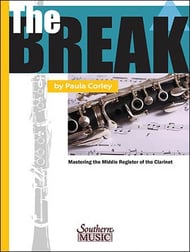 Paula Corley is a successful clarinetist and pedagogue. She has written several books and articles about the clarinet and clarinet teaching and has presented at numerous conferences including the Midwest Clinic, ClarinetFest®, and others across the US. She is an artist-clinician for Buffet-Crampon and Vandoren.
Paula Corley is a successful clarinetist and pedagogue. She has written several books and articles about the clarinet and clarinet teaching and has presented at numerous conferences including the Midwest Clinic, ClarinetFest®, and others across the US. She is an artist-clinician for Buffet-Crampon and Vandoren.
The Break is a source book for the developing clarinetist. It focuses on “crossing the break,” basically the interruption of the flow from “throat tones” to the clarion register. This book offers a step-by-step approach to lessen the frustration many clarinetists face. Part I includes register key exercises and clearly explained practice suggestions. Other topics, such as the importance of the embouchure and airstream working together, and tongue position, are explained. Tuning and undertones are discussed. Several more exercises are included to help develop finger dexterity in register shifting. Popular songs such as the “Largo” from the New World Symphony, America the Beautiful, and Greensleeves, to name a few, are written in the clarion register to allow the student to play a familiar song, rather than just exercises. I appreciate the emphasis on rhythms, dynamics, and articulations for each of the melodies and exercises.
Part II focuses on the Bona Preparatory Exercises, intentionally excluding dynamics and tempo markings to allow for concentration on rhythm, tonguing, and sound. Exploration of the altissimo register closes out this book. Suggestions for voicing and tongue position are included. In this section clear and concise clarinet fingering graphics are included.
Overall, I found this book to be informative and written in a manner that a young clarinetist could easily comprehend. The inclusion of popular songs and practice suggestions was especially thoughtful.
– Lori Ardovino
James Cohn. Three Pieces for Clarinet Alone, Op. 78. Subito Music Publishing, 1999. $10.95
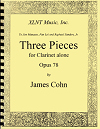 Three Pieces for Clarinet Alone, composed by the late James Cohn in 1999, was commissioned by Raphael Sanders, Jon Manasse, and Fan Li. The work consists of three short movements, “Wind Song,” “Slow Dance,” and “Polonaise.” Throughout the piece, Cohn expands on themes and interweaves melodies, resulting in a series of colorful, syncopated dances that are sure to delight audiences and performers alike!
Three Pieces for Clarinet Alone, composed by the late James Cohn in 1999, was commissioned by Raphael Sanders, Jon Manasse, and Fan Li. The work consists of three short movements, “Wind Song,” “Slow Dance,” and “Polonaise.” Throughout the piece, Cohn expands on themes and interweaves melodies, resulting in a series of colorful, syncopated dances that are sure to delight audiences and performers alike!
The quick and energetic “Wind Song” opens with low, soft prestissimo runs that vividly illustrate gusts of wind. As the movement progresses, it is as if the opening breeze transforms into a full windstorm and becomes more of a joyful dance than a song. “Slow Dance” contrasts beautifully with the energetic first movement. The sudden, dramatic dynamic changes interchange between faster slurred lines and slower staccato notes, and syncopation makes the dance feel mischievous. The movement concludes by fading to silence. “Polonaise” begins by introducing a forte dance in triple meter with clearly marked articulations that alternate between slurred and staccato. The main dance theme is gradually expanded and interspersed with accidentals.
Throughout each piece, Cohn constantly skirts around the tonic and only touches on it briefly before landing solidly on the tonic to end each movement. Cohn’s masterful accent placement, articulation distinctions, and wide dynamic range are engaging for the listener and the performer. Though clear in his marked instructions, Cohn’s writing still leaves much room for personal interpretation. Due to the large leaps across the range of the instrument at fast tempi and soft dynamics, the piece is appropriate for a strong intermediate-level or advanced performer. It is a wonderful example of Cohn’s brilliant writing and would be a fun and challenging addition to a recital program.
– Sarah Korneisel Jaegers
Alexandre Rydin. Quatre morceaux for bass clarinet. Gérard Billaudot Éditeur, 2022. €9.60
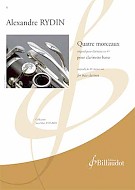 Alexandre Rydin’s (b. 1939) Quatre morceaux was originally for B-flat or A clarinet and was adapted by the composer for extended-range bass clarinet. The four brief movements: “Adagio lirico,” “Capriccio,” “Suspensus,” and “Impetuoso” total almost 10 minutes and are marked by introspective logic in the first and third, and by propulsive rhythmic and articulation materials in the second and fourth. The range is conservative, with little use of the lowest four bass clarinet semitones, and tops out at one altissimo F. With most of the music centered in the treble staff, delicate control is demanded for frequent break crossing.
Alexandre Rydin’s (b. 1939) Quatre morceaux was originally for B-flat or A clarinet and was adapted by the composer for extended-range bass clarinet. The four brief movements: “Adagio lirico,” “Capriccio,” “Suspensus,” and “Impetuoso” total almost 10 minutes and are marked by introspective logic in the first and third, and by propulsive rhythmic and articulation materials in the second and fourth. The range is conservative, with little use of the lowest four bass clarinet semitones, and tops out at one altissimo F. With most of the music centered in the treble staff, delicate control is demanded for frequent break crossing.
This effective piece is only medium-difficult considering the demands of some solo bass clarinet works. I enjoyed the contrasting movements and the feelings elicited by Rydin’s music which is chromatically charged and uses expressive dissonance. Form and logic prevail, and all thorny harmonic knots work themselves out by each movement’s end with a tonal cadence. The two fast movements are fun to play and I am sure I would enjoy hearing a skilled performance.
– Gregory Barrett
Georg Philipp Telemann. 12 Fantasias for Violin, transcribed for solo clarinet by Frédéric Matagne. HDSB Music Publishing, 2022. €24.90
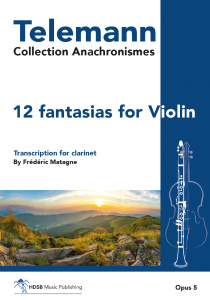 As noted in a previous review, Frédéric Matagne, Belgian founder of HDSB Music Publishing, writes informative prefaces in his publications. In them he has explained his admiration for Bach and Baroque music in general. Matagne’s aim is to fill his catalog with transcriptions of violin or cello pieces that can be played on the clarinet. Here we have the 12 Telemann Fantasias, originally titled Fantasie per il Violino senza basso. It is one of Telemann’s collections of music for unaccompanied instruments, such as the 12 Fantasias for solo flute, 36 Fantasias for solo harpsichord, and 12 Fantasias, recently rediscovered, for solo viola da gamba. Matagne made the clarinet transcriptions of the Telemann violin Fantasias directly from the original manuscript, not adding anything in terms of articulations or dynamics. Telemann conceived these Fantasias in two groups of six. Six of them include fugues and six are Galanterien, as he described these compositions. The formal structure of each Fantasia is quite different—in fact there can be three, four, or even six short movements, like a suite. These transcriptions are well done, pleasant, medium-difficult compositions, quite suitable to the clarinet. They are a good addition to the (transcribed) Baroque clarinet repertoire.
As noted in a previous review, Frédéric Matagne, Belgian founder of HDSB Music Publishing, writes informative prefaces in his publications. In them he has explained his admiration for Bach and Baroque music in general. Matagne’s aim is to fill his catalog with transcriptions of violin or cello pieces that can be played on the clarinet. Here we have the 12 Telemann Fantasias, originally titled Fantasie per il Violino senza basso. It is one of Telemann’s collections of music for unaccompanied instruments, such as the 12 Fantasias for solo flute, 36 Fantasias for solo harpsichord, and 12 Fantasias, recently rediscovered, for solo viola da gamba. Matagne made the clarinet transcriptions of the Telemann violin Fantasias directly from the original manuscript, not adding anything in terms of articulations or dynamics. Telemann conceived these Fantasias in two groups of six. Six of them include fugues and six are Galanterien, as he described these compositions. The formal structure of each Fantasia is quite different—in fact there can be three, four, or even six short movements, like a suite. These transcriptions are well done, pleasant, medium-difficult compositions, quite suitable to the clarinet. They are a good addition to the (transcribed) Baroque clarinet repertoire.
– Luigi Magistrelli
Guilherme Sampaio Garbosa. Rotina Para Warm Up Clarineta (Clarinet Warm-up Routine). Editora Coralina, 2022. $35.00
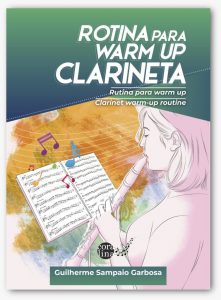 This book of warm-up exercises is in Portuguese, Spanish, and English. The routines focus on many typical parts of warm-ups, some familiar, some unfamiliar. Each section is preceded by a helpful explanation.
This book of warm-up exercises is in Portuguese, Spanish, and English. The routines focus on many typical parts of warm-ups, some familiar, some unfamiliar. Each section is preceded by a helpful explanation.
Of particular note is the first section, devoted to stretching. I really like this recommendation, and know many people will find it valuable, though it seems like one of the drawings is a shoulder stretch when the caption says “left arm.” After stretches, there are breathing exercises to do without the clarinet—also a good idea! I particularly liked No. 5 where you inhale, hold, inhale again, hold, inhale again, hold, then exhale slowly. This type of routine can really help students understand how much air they really have available.
The next section describes a good tone and how to get it. Though getting an idea of good tone from text is fairly futile, Garbosa describes vowel sounds that I have known many other teachers to use. This is one of many sections that I wish had an accompanying video. The notated exercises that follow are fairly standard—so, good ones to use!
The section on technique follows, and showcases a confusing thing about this book: I’m not sure what level of player is targeted. In the technique introduction, the author seems to be describing minor scales to someone unfamiliar with them, as well as introducing the concept of alternating pinkies instead of sliding around on the keys. It’s good advice for sure, but some of the exercises that follow are on par with Baermann Book 3, and the fingering chart goes to double-high C. He also recommends doing this warm-up for 30 minutes every day, which I don’t think students who’ve never played a minor scale will do. Perhaps he’s just trying to be comprehensive—always a good strategy—or perhaps the program most students go through in the US is different from the program in Brazil.
Articulation is next, and I really like the variations in slurs presented! There are even articulated scales in 7/8 so one can practice an octave at a time. The fingering chart at the end has good fingerings, but the numbering/lettering of keys on the clarinet picture is confusing, and code in the chart is only footnoted in Portuguese.
Overall, I think it’s a good book, comprehensive and well thought out. I like that most of the ideas come from a teaching tradition I am unfamiliar with, and I enjoyed looking at the clarinet and warming up with fresh eyes. Both students and teachers will likely get some good ideas from it. I hope Mr. Garbosa will make accompanying videos!
– Sean Osborn
Caroline Schleicher-Krähmer. Sonatine pour Piano avec Clarinette ou Violon oblige. Publication by Nicola Buckenmaier, 2022. Digital orders from www.carolineschleicher.com/order. €15.00
 In the past, female composers had an uphill battle to practice their art. Obligations of marriage and motherhood were among the main discrimination obstacles against them. Fortunately, from the beginning of the 19th century societal restrictions eased somewhat, and some women gained much more recognition. The German composer and clarinetist Caroline Schleicher-Krähmer (1794-1873) was one of them. I would like to also mention that the Italian composer of the late 17th century, Camilla De Rossi, inserted in her oratorio Il Sacrifizio di Abramo (1708) an obbligato chalumeau part. Additional women composers from the 18th and 19th centuries writing for the clarinet included Marianna Bottini, Maria Grandval, Anna Amalia von Sachsen-Weimar, Augusta Holmes, and Alice Mary Smith.
In the past, female composers had an uphill battle to practice their art. Obligations of marriage and motherhood were among the main discrimination obstacles against them. Fortunately, from the beginning of the 19th century societal restrictions eased somewhat, and some women gained much more recognition. The German composer and clarinetist Caroline Schleicher-Krähmer (1794-1873) was one of them. I would like to also mention that the Italian composer of the late 17th century, Camilla De Rossi, inserted in her oratorio Il Sacrifizio di Abramo (1708) an obbligato chalumeau part. Additional women composers from the 18th and 19th centuries writing for the clarinet included Marianna Bottini, Maria Grandval, Anna Amalia von Sachsen-Weimar, Augusta Holmes, and Alice Mary Smith.
Fortunately nowadays we have plenty of clarinet works written by contemporary female composers. The Swiss musicologist Nicola Buckenmaier thoroughly researched Schleicher-Krähmer’s life and activity. She was the first female composer to write a clarinet piece. Buckenmaier has created a website dedicated to Schleicher-Krähmer and has produced a publication edition of her Sonatina for clarinet and piano. Buckenmaier’s biographical article on Schleicher-Krähmer was published in the September 2019 edition of The Clarinet.
Schleicher-Krähmer was a talented musician who studied piano, violin, and clarinet and also taught her students guitar and voice. She had a solo career, making concert tours in Europe, performing both on violin and clarinet. When she married Viennese oboist Ernst Krähmer she further developed her career as a clarinetist. It was still very unusual during Schleicher-Krähmer’s lifetime that a woman was able to compose and publish her own works. She faced discrimination playing clarinet and violin because it was considered indecent for women to perform in public. Schleicher-Krähmer was not only the first female clarinet soloist, but also, the only one at her time. Her Sonatina for clarinet (or violin) and piano is an unpretentious, pleasant composition published in 1825 in Vienna by Sauer and Leidesdorf, and it includes a Viennese waltz. So far, no manuscript of this piece has been tracked down, but in modern times it appeared in György Balassa’s 1979 Edition Musica Anthology. This very recent, fine, and accurate publication by Buckenmaier is most welcome! She did an exemplary job correcting all errors and adding the clarinet line, now with rehearsal numbers, to the piano score. She also included a very long and informative preface, and editorial remarks.
– Luigi Magistrelli
Johannes Brahms. Duo for clarinet and piano. Arranged by Paul Klengel from the Quintet, op. 115. Edited by Nicolai Pfeffer. Clarinova TrioMusik, 2022. €29.00
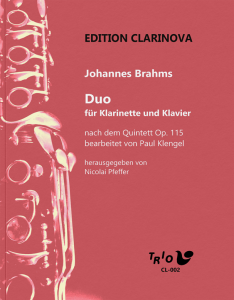 The Brahms Quintet, op. 115 is considered by all critics to be one of the most significant clarinet masterpieces. Johannes Brahms, in his autumn days, was tired of composing, but luckily for clarinetists he received incredible inspiration from Richard Mühlfeld, who he heard perform as principal clarinet in the Meiningen orchestra. The Quintet was the second of the four clarinet gems he composed (the others being the Trio, op. 114, and the two Sonatas, op. 120). Every good clarinetist in the world should know this story, of course, but not all of them are aware of the fact that in the lifetime of Brahms this quintet had a good number of different arrangements, due to its enormous success from 126 documented performances! Mühlfeld himself played the clarinet and piano version.
The Brahms Quintet, op. 115 is considered by all critics to be one of the most significant clarinet masterpieces. Johannes Brahms, in his autumn days, was tired of composing, but luckily for clarinetists he received incredible inspiration from Richard Mühlfeld, who he heard perform as principal clarinet in the Meiningen orchestra. The Quintet was the second of the four clarinet gems he composed (the others being the Trio, op. 114, and the two Sonatas, op. 120). Every good clarinetist in the world should know this story, of course, but not all of them are aware of the fact that in the lifetime of Brahms this quintet had a good number of different arrangements, due to its enormous success from 126 documented performances! Mühlfeld himself played the clarinet and piano version.
Paul Klengel (1854-1935) made five different arrangements, including the present one, but also piano four hands, violin and piano, two pianos, and solo piano. Brahms was quite happy and satisfied about that, being himself an arranger of his own works. Klengel was able to transcribe all the string parts into the demanding piano version, keeping the solo clarinet part almost unchanged. The outcome is amazing and interesting, but of course the timbral richness of the velvet carpet of the strings is lost. Nicolai Pfeffer has edited the Simrock first edition (1893) correcting without comment obvious engraving and notation errors, and discrepancies between the clarinet part in the piano score and the single part. The result from the German publishing house Clarinova Triomusik is accurate and appealing. Thanks to our indefatigable Nicolai Pfeffer for producing such interesting clarinet publications.
– Luigi Magistrelli
Jennifer Margaret Barker. Ocean of Glass for flute, clarinet, and piano. McKenna-Keddie Publishing, 2021. $30.00 (postage included) from the composer’s website.
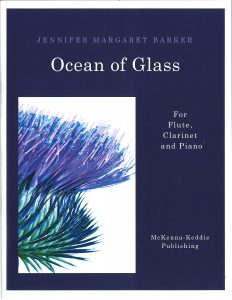 The works of Scottish-American composer Jennifer Margaret Barker have been heard by audiences of major orchestras such as those in St. Louis and Detroit. She is on the faculty of the University of Delaware, which is fortunate for us because of her collaboration with the ICA’s recent secretary Christopher Nichols and his premiere performance of Ocean of Glass in 2021.
The works of Scottish-American composer Jennifer Margaret Barker have been heard by audiences of major orchestras such as those in St. Louis and Detroit. She is on the faculty of the University of Delaware, which is fortunate for us because of her collaboration with the ICA’s recent secretary Christopher Nichols and his premiere performance of Ocean of Glass in 2021.
Barker’s instrumental background of piano, violin, and oboe gives her a practical feel for her chosen ensemble. Her scoring is idiomatic and effective. Inspired by a June 2019 voyage through Alaska’s stunning Inside Passage, her music ripples on a sea of serenity and expressive timelessness. This one-movement, eight-minute, medium-difficult trio reminds me of Debussy’s Sonata for Flute, Viola and Harp with similar suppleness of structure, appealing shortish melodic gestures alternating with long melisma, gentle major seconds, and like in Debussy’s piano oeuvre, deep bass notes—including in the final chord. The piano writing is further marked by coloristic pedaling allowing for the accumulation of mystical sounding chords.
This trio is a winner, and a sure source of enjoyment for you and your audience.
– Gregory Barrett
Ernesto Nazareth. Zizinha, Polka for clarinet and piano arranged by Heinz Bethmann. Musikverlag Bruno Uetz, 2021. €10.00
 Ernesto Nazareth lived from 1863 to 1934. This short, two-page polka has an introduction that features a passage of ascending trills with grace notes. The next section has 16th-note patterns that leap up by octaves. Lastly, a D.C. brings back the themes once again. Nazareth was known for combining diverse styles into his music and this polka seems to have slight Brazilian and ragtime hints. He is known for composing tangos, waltzes, and polkas (28 in total) among other works mostly for the piano. Bethmann did a good job creating an idiomatic arrangement of this for clarinet.
Ernesto Nazareth lived from 1863 to 1934. This short, two-page polka has an introduction that features a passage of ascending trills with grace notes. The next section has 16th-note patterns that leap up by octaves. Lastly, a D.C. brings back the themes once again. Nazareth was known for combining diverse styles into his music and this polka seems to have slight Brazilian and ragtime hints. He is known for composing tangos, waltzes, and polkas (28 in total) among other works mostly for the piano. Bethmann did a good job creating an idiomatic arrangement of this for clarinet.
– Katrina Phillips
Kinder & Volkslieder (Children & Folk Songs) for two clarinets arranged by Rainer Mühlbacher. Books 1 and 2, Musikverlag Bruno Uetz, 2021. Each €11.00
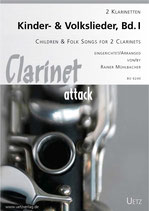 There are 22 duets in Book 1 of these Children and Folk Songs; each is about four to five staves long. The duets have the words written below the melodies so they can be sung before or after being played on the clarinet. The book is decorated with black and white drawings of characters such as animals that go along with the themes. Some songs include: “On the Bridge of Avignon,” “Happy Birthday to You,” and “Brother Jakob.” Book 2 has 25 duets, including “Oh Dear Augustine,” “Listen Sir,” and “Bear Dance.” There are several rounds in the book. I think children would enjoy playing these melodies.
There are 22 duets in Book 1 of these Children and Folk Songs; each is about four to five staves long. The duets have the words written below the melodies so they can be sung before or after being played on the clarinet. The book is decorated with black and white drawings of characters such as animals that go along with the themes. Some songs include: “On the Bridge of Avignon,” “Happy Birthday to You,” and “Brother Jakob.” Book 2 has 25 duets, including “Oh Dear Augustine,” “Listen Sir,” and “Bear Dance.” There are several rounds in the book. I think children would enjoy playing these melodies.
– Katrina Phillips
Josef Bönisch. Little Duets. Musikverlag Bruno Uetz, 2019. €7.50
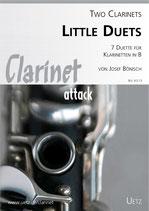 This collection includes seven duets for two clarinets: “Tänzerisch bewegt,” “Legend,” “Alla Barock,” “Jazzing,” “Scherzando,” “Andante moderato,” and “Happy Moments,” totaling seven pages of music. It is best saved for a third-year player as it involves playing in 6/8 time, a cadenza, mixed meter, and B-flat above the staff.
This collection includes seven duets for two clarinets: “Tänzerisch bewegt,” “Legend,” “Alla Barock,” “Jazzing,” “Scherzando,” “Andante moderato,” and “Happy Moments,” totaling seven pages of music. It is best saved for a third-year player as it involves playing in 6/8 time, a cadenza, mixed meter, and B-flat above the staff.
– Katrina Phillips
Musik für kleine und größere Vögel (Music for Small and Big Birds): 32 Famous Songs for two clarinets in B-flat, arranged by Rainer Mühlbacher. Musikverlag Bruno Uetz, 2020. €14.00
 This contains 36 short duets including “Amazing Grace,” “Danny Boy,” “Bingo,” “We shall Overcome,” “The Last Rose of Summer,” “The First Noel,” and others. Rhythms are very straightforward. The pitches are usually within the staff or below, so a first-year student could easily play from this book. The cover is pretty, with hand-drawn bluebirds with music notes in their mouths; it fits the title appropriately. This book is also arranged for clarinet and bassoon.
This contains 36 short duets including “Amazing Grace,” “Danny Boy,” “Bingo,” “We shall Overcome,” “The Last Rose of Summer,” “The First Noel,” and others. Rhythms are very straightforward. The pitches are usually within the staff or below, so a first-year student could easily play from this book. The cover is pretty, with hand-drawn bluebirds with music notes in their mouths; it fits the title appropriately. This book is also arranged for clarinet and bassoon.
– Katrina Phillips
Gaetano Donizetti. De Torrente, duet for soprano, tenor, two obbligato clarinets and orchestra (piano). Nico Bertelli Edizioni Musicali, 2016. €12.00
Gaetano Donizetti. Laudamus Te, aria for soprano, obbligato clarinet and orchestra (piano). Nico Bertelli Edizioni Musicali, 2016. €12.00
Gaetano Donizetti. Qui Tollis, aria for tenor, clarinet and organ. Nico Bertelli Edizioni Musicali, 2014. €12.00
We already reviewed in this magazine two arias by Paisiello and Paer with obbligato clarinet, published by Nico Bertelli, who seems to be so interested in this medium. In fact in his internet catalog he includes many other arias with obbligato clarinet and soprano or tenor or bass, written by distinguished composers such as Donizetti, Mayr, Mercadante, Graupner (soprano chalumeau) and above all quite minor composers such as Possl, Wanhal, and Cartellieri. Donizetti (1797-1848) lived in Bergamo (northern Italy) and was a very prolific opera composer—70 operas! His teacher was G. S. Mayr, who also wrote a large number of arias with obbligato instruments including clarinetto dolce intended as the clarinet d’amour. Donizetti liked the clarinet a lot; in fact, he wrote a Concertino, two Studies for clarinet alone, and clarinet and bass, and a large number of arias with obbligato clarinet. I would like also to cite the short, pleasant Canzonetta with soprano Or che la notte invita.
The three arias with Latin text reviewed here are quite interesting both for their musical content and the instrumental combinations. De Torrente includes soprano and tenor voices with two C clarinets. Laudamus te is for soprano (part reconstructed by Nico Bertelli) with obbligato clarinet and Qui Tollis has a tenor with obbligato clarinet accompanied by an organ. The clarinet has not only a melodic role in these arias but also demanding virtuoso passages. Bertelli offers us rare arias with obbligato clarinet that should be more known for their musical value. Thanks, Nico!
– Luigi Magistrelli
Casimir Antonio Cartellieri. Clarinet Concerto No. 3 in E-flat major. Edited by Marco Giani. Clarinova TrioMusik, 2022. €26.00
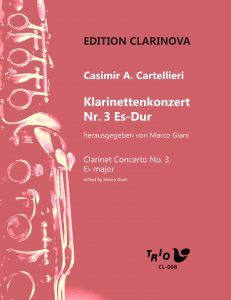 Casimir Antonio Cartellieri (1772-1807) was a German late classical composer with Italian origins (from his father) who was for a long time neglected in spite of his many composing abilities. The well-known German clarinetist and researcher Dieter Klöcker (1936-2011) was the first who made some efforts to rediscover his clarinet compositions, recording six CDs produced by the MDG and CPO labels. He recorded the three Clarinet Concertos (the second one has only the slow movement), Allegro aperto for clarinet and orchestra, Concerto for two clarinets and orchestra, four Quartets with strings, Divertimento for winds and strings, three Parthias for wind sextet, and three Divertimentos for wind octet. MDG also produced more Cartellieri CDs including his six symphonies and the two operas Gioas and Re di Giuda.
Casimir Antonio Cartellieri (1772-1807) was a German late classical composer with Italian origins (from his father) who was for a long time neglected in spite of his many composing abilities. The well-known German clarinetist and researcher Dieter Klöcker (1936-2011) was the first who made some efforts to rediscover his clarinet compositions, recording six CDs produced by the MDG and CPO labels. He recorded the three Clarinet Concertos (the second one has only the slow movement), Allegro aperto for clarinet and orchestra, Concerto for two clarinets and orchestra, four Quartets with strings, Divertimento for winds and strings, three Parthias for wind sextet, and three Divertimentos for wind octet. MDG also produced more Cartellieri CDs including his six symphonies and the two operas Gioas and Re di Giuda.
Cartellieri’s compositions are preserved in various Austrian and Czech libraries. He was active in Vienna; very probably Antonio Salieri was his teacher. Cartellieri then filled two positions, first as composer and music director for the Polish Count Oborsky and then serving Prince Lobkowitz. With his activities he was in touch with the most famous composers of those times, including Beethoven, from whom he gained stylistic influences with clear classical and early Romantic characteristics.
In spite of the fact that there are no dedications on the manuscripts of the clarinet compositions of Cartellieri, it is very likely that the composer had contacts in Vienna with the clarinet virtuoso Anton Stadler. In fact, the clarinet concertos are highly virtuosic and quite difficult to be performed by a player with average abilities.
Marco Giani is the principal clarinetist in the Pomeriggi Musicali Chamber Orchestra of Milan. With the same orchestra he premiered in Italy (maybe not only in Italy!) the Cartellieri Clarinet Concerto No. 3 after working hard preparing a new modern beautiful edition for Clarinova TrioMusik Edition. Nico Bertelli (Nico Bertelli Edizioni Musicali) had been working previously on Cartellieri clarinet repertoire publishing (only) the separate clarinet parts from the three Concertos, Concerto for Two Clarinets, and the aria Alma fides corda rege for soprano, clarinet, and orchestra. Giani was very accurate about the original writing of Cartellieri, both leaving the original articulations and his dotted version suggestions. The piano part has been made by himself, Davide Martelli, and Giacomo Ferrari. He also wrote his own well conceived and appealing cadenzas for each movement (a big one for the first movement, a short one for the second, and two cadenzas for the third movement). The content of the Preface is very informative and reflects all known sources. This is a highly recommended new modern edition of a beautiful unknown clarinet concerto that deserves to be rediscovered and performed. Bravo to Marco Giani for his valuable work!
[See Marco Giani’s article on the Cartillieri Concerto No. 3 in this issue. Ed.]
– Luigi Magistrelli
Johann Simon Mayr. Concerto for Basset Horn and Orchestra. Edited by Francesco Belli and Antonio Fraioli. Vigor Music, 2022. www.vigormusic.it. €22.00
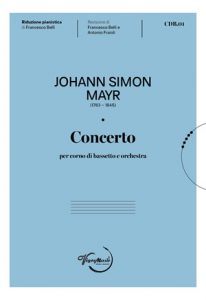 Johann Simon Mayr (1763-1845) was an Italian composer (as he wanted to be remembered) but with German origins. He is one of the most significant and prolific opera and sacred music composers of the 19th century, but above all he was the teacher of Gaetano Donizetti, who gained more renown than Mayr in Italian opera in the first part of the 19th century. Mayr loved the clarinet and the basset horn, writing a large number of works in solo, chamber music, and orchestral contexts. He inserted obbligato clarinet or basset horn solos into many of his sacred scores, and also wrote solos for clarinetto dolce in G, the clarinet d’amour. Worthy of mention is his curious Concerto Bergamasco for piccolo, flute, clarinet, and basset horn, to be played by two performers, since these various instruments are never playing all together. It was dedicated to multi-instrumentalist Giovanni Sangiovanni (virtuoso on the clarinet, basset horn, and flute). Another particularly interesting and well-written work is the Twelve Bagatelles for flute, clarinet, and basset horn, as is the virtuoso Theme and Variations for clarinet and orchestra (published by Nico Bertelli).
Johann Simon Mayr (1763-1845) was an Italian composer (as he wanted to be remembered) but with German origins. He is one of the most significant and prolific opera and sacred music composers of the 19th century, but above all he was the teacher of Gaetano Donizetti, who gained more renown than Mayr in Italian opera in the first part of the 19th century. Mayr loved the clarinet and the basset horn, writing a large number of works in solo, chamber music, and orchestral contexts. He inserted obbligato clarinet or basset horn solos into many of his sacred scores, and also wrote solos for clarinetto dolce in G, the clarinet d’amour. Worthy of mention is his curious Concerto Bergamasco for piccolo, flute, clarinet, and basset horn, to be played by two performers, since these various instruments are never playing all together. It was dedicated to multi-instrumentalist Giovanni Sangiovanni (virtuoso on the clarinet, basset horn, and flute). Another particularly interesting and well-written work is the Twelve Bagatelles for flute, clarinet, and basset horn, as is the virtuoso Theme and Variations for clarinet and orchestra (published by Nico Bertelli).
This Concerto for Basset Horn and Orchestra, published for the first time by Vigor Music, is a rather brief composition consisting of only two movements: a cantabile lyrical Largo followed by a short brilliant and cheerful Allegretto. In the informative preface, Adriano Amore writes that this concerto was performed for the first time by the amateur player Giovanni Battista Belli, under the direction of the composer on March 19, 1819, at the Teatro della Società in Bergamo.
We must be grateful to Francesco Belli and Antonio Fraioli for publishing for the first time this short but nice basset horn concerto, preserved at the Angelo Mai Civic Library of Bergamo. According to Bertelli, this Concerto, written in 1819, could possibly have been included by Mayr as part of the above mentioned Concerto Bergamasco.
Vigor Music publishes versions with either piano or orchestra accompaniment.
– Luigi Magistrelli
Comments are closed.